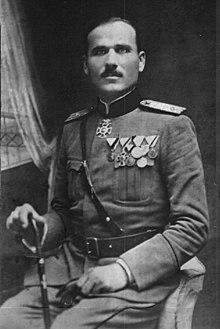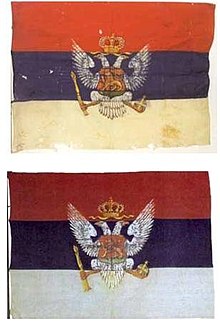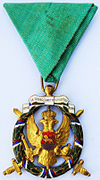Greens (Montenegro)

TheGreens(Serbo-Croatian:Зеленаши,Zelenaši) were a group of loyalists ofKing NikolaofMontenegro.They originated from the members of theTrue People's Partyand were most notable for instigating theChristmas Uprisingof 1919. The rebellion was staged in an attempt to prevent the dethroning of thePetrović-Njegoš dynastyand the subsequent integration of Montenegro into theKingdom of Yugoslavia.The Greens were supporters of the House of Petrović-Njegoš, which once the house was dethroned afterWorld War I,led the Greens to fight for the establishment of Montenegro as a province within the Yugoslav kingdom. Following their defeat in the Christmas Rebellion, the Greens continued on with their guerrilla warfare until 1929. Themottoof the movement was "For the Right, Honour and Freedom of Montenegro".
During World War II, the Greens were activated once again under the leadership ofKrsto Popovićin an attempt to re-establish theKingdom of Montenegroas anAxisclient state.[1]
Characteristics
[edit]The Greens (Zelenaši) movement was originally founded in 1918 inMontenegroby the opponents of Montenegrin unification with theKingdom of Serbiaand integration into the newly establishedKingdom of Yugoslavia,when they supported theHouse of Petrović-Njegošof Montenegro over theHouse of Karađorđevićof Serbia. After the unsuccessful armed rebellion known as the Christmas Rebellion, the Greens continued guerrilla resistance until 1929, while their political activity was based on opposition to the mode and manner in which thesouth Slavicunification was implemented, resulting in the disappearance of Montenegro as a political entity. According to the Croatian-American academicIvo Banacthey declared themselves asSerbs.[2][3][4] As a member of a joint American–British mission, the British diplomat Earl John de Salis wrote a detailed report. The Earl stated that no one denied that Montenegro might need to be unified with Serbia and the budding Yugoslav state. However, the issue was “to be able to join it as Montenegro, and not as a prefecture of Serbia, as free Montenegrins, in line with the tradition and the past of their country, and not as yes-men of Belgrade, to join it on equal footing as the Slovenes, the Croats and the very Serbs.”,[5]i.e.on conditions of equality and preservation of identity of Montenegro.[6]
The Greens drew their membership from the Highland tribes (Moračani,Piperi,andRovci), the Katun clans (Bjelice,Cetinje,Čevo,andCuce), and the Herzegovinian tribes (Nikšići,Rudinjani andDrobnjaci).[7]Notable leaders of the Greens includedKrsto Zrnov Popović,Jovan S. PlamenacandNovica Radović.
Some of the Greens re-gathered duringWorld War II,under the command of Krsto Zrnov Popović, a collaborator offascist Italy.They were organized into a military unit called theLovćen Brigadefeaturing four brigades that participated in the chaotic civil war raging on the ground in Montenegro and whose military activity was mostly directed against the communistPartisans.After their military defeat, most of the surviving Greens members joined the Partisans, with some joining theUstašeand a minority joining theChetniks.Other members of the Greens joined Partisans or Chetniks from the beginning of the Axisinvasion of Yugoslavia.
Name
[edit]The name of theGreensderives from the green voting cards that were used by the opponents of unification with Serbia used at thePodgorica Assemblyin 1918.
History
[edit]This sectionneeds additional citations forverification.(October 2018) |
Christmas Rebellion
[edit]

TheGreensopposed the unification of theKingdom of Montenegrowith theKingdom of Serbiaunder theHouse of Karađorđević.With support from Italy, the Greens organised a rebellion in 1919 with the aim of bringing theHouse of Petrović-Njegošback to the Montenegrin throne. The rebellion failed and the rebels fled to Italy.Krsto Zrnov Popović,Jovan PlamenacandNovica Radovićled the uprising, along with Commander Savo Čelebić and Captain Đuro Drašković.
Interwar period
[edit]After the unsuccessful uprising, the Greens returned to Montenegro, starting a guerrilla warfare. The core of the revolt was subdued in 1922–1923, but low-level guerrilla continued in the mountains and highlands for several more years. In 1922, a number of leaders of the Greens founded theMontenegrin Federalist Party,shifting from organised armed resistance to political struggle.
By 1926, most remaining forms of armed resistance ended. However, a few groups continued engaging in skirmishes until 1929.
World War II: restoration and dissolution
[edit]In World War II, theGreenswere organized yet again in Montenegro under the command of theFascist Italy.Sekula Drljevićwas put in power and proclaimed the re-establishment of an independent Montenegro, but was immediately ousted by the13 July uprisingof localPartisansandChetniks.Among the Montenegrin federalists, Krsto Zrnov Popović returned from exile in Italy to attempt to lead the Greens. The Greens' forces were called theLovćen Brigade.Soon, they were disorganized and one group of Greens joined the Partisans, while another joined the CroatianUstašeand some joined the Chetniks.
After the Partisan victory in 1945, many leaders of the Greens were killed as the collaborators of the Italian occupation: the same Popović was murdered in 1947. At the same time, the Communists were killing many potential opponents all overYugoslavia.This marked the end of the Greens.
Order of Freedom of Montenegro
[edit]
The Order of Freedom of Montenegro was issued by the exiledKing Nikolain January 1919. This order was mainly dedicated to the Greens.
See also
[edit]Notes
[edit]- ^Roberts 1987,p. 24.
- ^Banac, Ivo(1992),Protiv straha: članci, izjave i javni nastupi, 1987-1992(in Croatian), Zagreb: Slon, p. 14,OCLC29027519,retrieved12 December2011,
Posebno je zanimljivo da su se i »zelenaši«,...., nacionalno smatrali Srbima "[it is especially interesting that Greens also... declared themselves as Serbs]
- ^Banac, Ivo(March 1988),The national question in Yugoslavia: origins, history, politics,Cornell University Press, p. 288,ISBN9780801494932,retrieved17 November2011,
In a letter to the Serbian commander in Rijeka Crnojevića, the local head of the Green insurgents noted thatMontenegro, our Fatherland, had defended and safeguarded the torch of Serb freedom for six hundred years
- ^Banac, Ivo(March 1988),The national question in Yugoslavia: origins, history, politics,Cornell University Press, p. 290,ISBN9780801494932,retrieved17 November2011,
The Greens, especially after those among them who were not compromised by insurgency entered electoral politics on a federalist(autonomist) platform (1923) and then established the Montenegrin Party (1925), increasingly shunned armed struggle and stressed that, though they were for a federal Yugoslavia, they remained true Serbs.
- ^Petersen, Roger D. (2011).Western Intervention in the Balkans: The Strategic Use of Emotion in Conflict.Cambridge University Press. p. 273.ISBN9781139503303.Retrieved2 October2018.
- ^Banac, Ivo(March 1988).The national question in Yugoslavia: origins, history, politics.Cornell University Press. p. 288.ISBN9780801494932.Retrieved17 November2011.
- ^Banac, Ivo(March 1988).The national question in Yugoslavia: origins, history, politics.Cornell University Press. p. 285.ISBN9780801494932.Retrieved17 November2011.
References
[edit]- Roberts, Walter R.(1987).Tito, Mihailović and the Allies: 1941–1945.New Brunswick, New Jersey:Duke University Press.ISBN978-0-8223-0773-0.
